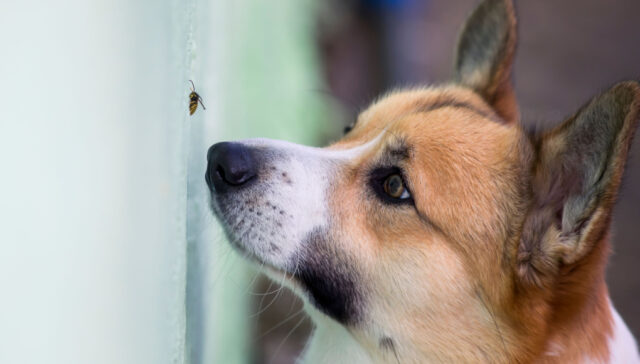
Table of Contents
Oh no! My dog ate a fly! What should I do?
Well, first of all, your dog must’ve been a nimble fellow to catch a fly mid-air.
I couldn’t swat a fly myself, so that must’ve been a feat to see!
Secondly, eating flies is not a common thing that dogs do.
There must’ve been something that triggered your dog to eat flies.
But the bigger question is whether your dog is in trouble after eating flies.
And that’s what we’re about to find out.
So, for this blog, I’ll be answering your questions concerning your dog eating a fly.
To do that, we’ll talk about the following topics in this article:
- Can dogs eat flies?
- Why do dogs eat flies?
- What happens when your dog eats a fly?
- What are the health risks encountered when your dog eats a fly?
- What to do if your dog eats a fly?
- What other insects can harm your dog?
Should you be worried that your dog ate a fly?
Let’s find out!
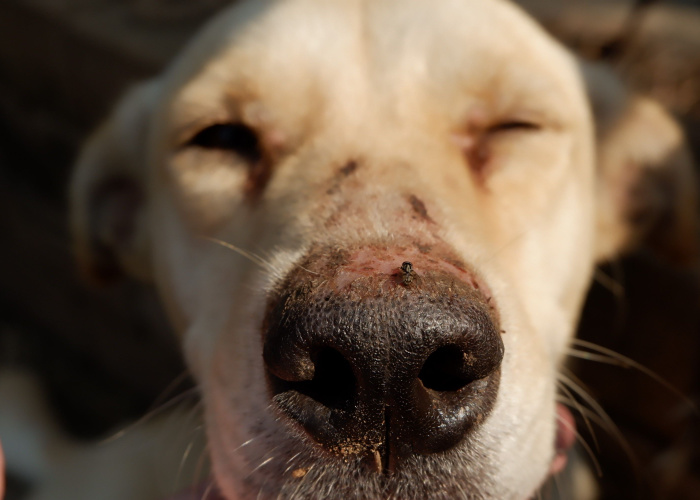
My Dog Ate a Fly: Is My Dog in Danger?
Help! My dog ate a fly. Is my dog in danger?
No, eating flies won’t place your dog in immediate danger.
This housefly species, Musca domestica, is not a poisonous insect that can inflict toxic effects on dogs.
House flies themselves may not be poisonous to your dogs, but they can still harm your dog in other ways.
In fact, the University of Florida's Entomology and Nematology Department also said:
Although this fly species does not bite, the control of Musca domestica is vital to human health and comfort in many areas of the world.
More of these flies’ harmful effects later.
What Happens if My Dog Ate a Fly?
Dan, what happens if my dog eats a fly?
Since flies are non-poisonous insects, the answer to that is nothing.
Your dog will be more or less alright.
It will digest the fly in its stomach like any other food that it has eaten, making these insects safe to eat.
Just take note that adult flies have no significant nutritional value.
So, unless your dog is feasting on fly larvae, it’s not worth feeding your dogs with houseflies.
The bigger question is, why would you feed your dog fly larvae if there’s a better option available for them?
Health Risks When Dog Eats Flies
So, flies are safe to eat.
But does that mean you should let your dog eat any critters as it pleases?
No, silly!
Just because dogs can eat flies doesn’t mean you should let them snatch some mid-air flies.
Letting dogs eat flies exposes them to various types of health risks.
The two most common health risks that dogs often encounter when they eat flies are insecticide poisoning and exposure to microbial infection.
Microbial Infection
Flies are notorious carriers of diseases not only to humans and dogs but to many creatures as well.
This is because flies carry a lot of microbes in their body as they move around the area or from one infected creature to another.
Fortunately for dogs and humans, most of the disease-causing microbes that flies carry get killed in the stomach.
The acidic stomach of dogs makes a hostile environment for bacteria and viruses to thrive in and survive.
In fact, there is a study in 1986 that shows dogs’ stomach acid is stronger than that of humans!
But some microbes can survive inside their stomachs and can make your dog sick.
Some of the known microorganisms that can survive the acidic nature of the stomach are also food-borne pathogens.
These are:
- E. coli
- Salmonella
- Helicobacter
- L. monocytogenes
- C. jejuni
- Yersinia spp
Insecticide Poisoning
Flies doused with bug sprays but managed to survive will be the vector of the toxins from the insecticide.
When your unfortunate dog comes across these insects and eats them, it will indirectly absorb the toxins from the spray.
If the bug spray that you applied around your house is not pet-safe, your dog may suffer from severe insecticide poisoning.
Some of the pesticides that are harmful to your dogs are:
- Carbamate insecticides
- d-Limonene
- Methoxychlor
- Pyrethrins or pyrethroids
RELATED: 7 Common Household Hazards That Can Harm Your Pet
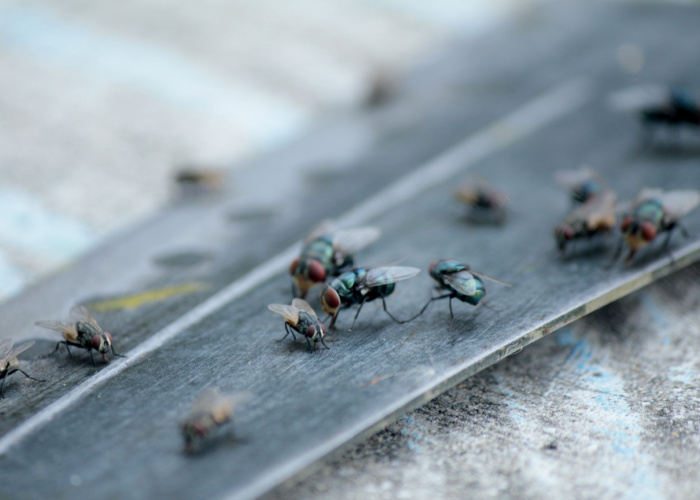
What To Do if Your Dog Ate a Fly?
Dan, my dog ate a fly. What do I do if that happens?
Eating flies is safe, even if it's gross to think about it.
But the microbes and pesticide toxins that come with the flies aren’t.
And that’s what you need to look out for in scenarios where your dog had eaten a fly.
Here’s what you should do in case your dog eats a fly.
Observe Your Dog for Symptoms
Always assume the worst case in this fly-eating incident and treat it as if your dog is already exposed to the risks.
Now, observe your dog for symptoms and check its condition for a few days.
But Dan, for a few days? That’s too long!
Yes, it is.
Unlike toxins, microbial infections follow stages of infections.
This means that it would take some time for the symptoms to appear.
Some viruses, like the Canine Parvo disease, can have an incubation period of up to seven days!
So, unless your dog has swallowed a poisoned fly, you need to keep an eye on your beloved dog for a few days to confirm your dog’s sickness.
Call Your Veterinarian
It would also be nice to place a call to your local vet.
When you’re on a call with your veterinarian, report all your observations to him.
From the symptoms to the details of the incident, tell everything to your veterinarian.
Otherwise, your vet can’t provide a straightforward solution to your dog’s suffering.
RELATED: Telehealth for Pets: 24/7 Vet Guidance
Bring Your Dog to the Veterinary Clinic
Finally, if your dog’s symptoms worsen, don’t waste a second and bring your dog to a veterinary clinic for better treatment.
You can also take your dog to the vet for a follow-up check-up on your dog’s condition.
RELATED: 22 Signs and Symptoms That Require an Immediate Vet Visit
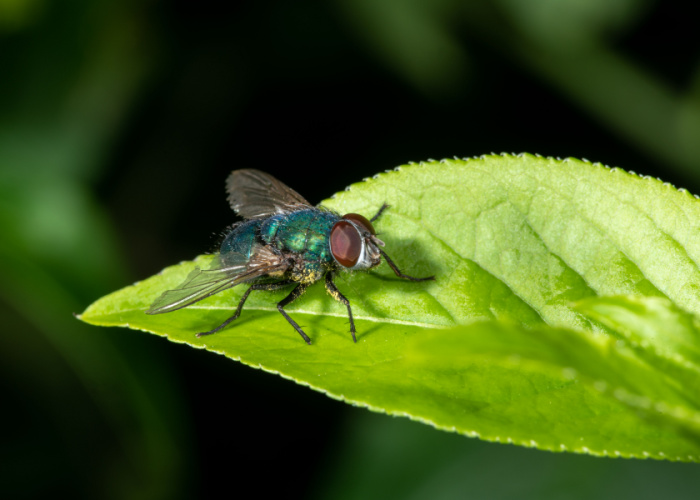
Why Did My Dog Eat a Fly?
Flies are not dogs’ primary source of diet, and so are insects, in general.
But for some reason, even when you’re giving them sufficient food for the day, they’ll still keep on eating flies.
So, what’s the problem? You’re probably asking, “Why did my dog eat a fly?”
Unless you’re really not feeding your dog right, their fly-eating behaviors are more of an instinct problem instead.
Here are some of the reasons that explain their behavior.
Preying Instinct
Dogs, regardless of what dog breed groups they’re in, are hard-wired with hunting instincts.
Their hunting instincts go all the way back from their wolf ancestors.
This means dogs naturally have some preying tendencies that drive them to catch small creatures.
It just so happens that the fly your dog ate became the unfortunate victim of its instincts.
Boredom
Yes, dogs can get bored too!
In fact, some dogs—especially the smart ones—will require a lot of mental stimulation to keep them entertained.
Without satisfying its need for entertainment, your dog will get bored and will resort to destructive behaviors.
And one of those is doing unusual things like catching and eating flies.
RELATED: 10 Ways to Relieve Boredom in Dogs
Anxiety and Stress
When your dog is in panic, or it’s suffering from anxiety, they also do unusual behaviors.
Some of their behaviors, like being aggressive, are a means to get defensive and find comfort and safety.
Other behaviors, on the other hand, are just your dog’s way to alleviate themselves from the stress and anxiety.
And yes, one of those behaviors to help them alleviate stress is by eating insects like flies.
What Other Insects Can Harm Your Dog?
Guess what? It’s not only the flies that you look out for!
Turns out that there are a lot of insects that can inflict harm on your dogs.
And if you’re not careful, that insect that your dog ate can be its last.
Below are some of the common insects that can harm your dog.
Steer your dog away and prevent them from trying to eat these insects.
Bees and Wasps
Your dog is not safe from bees.
Even honeybees have mild venom on their stings that can cause inflammation or irritation.
And like humans, dogs also get varied reactions from the stings depending on how their body reacts to them.
Some dogs can survive unscathed after receiving a few stings from them.
While other dogs can go into a life-threatening anaphylactic shock from just one sting.
And that’s only a group of tamer bee species that we’re talking about!
Imagine what wild bees and wasps can do to your dog.
Unfortunately, it’s common for dogs to prey upon these stinging insects as a mid-air snack.
The stings would eventually pop out and reveal itself as the bee’s means of defense against its predator.
Such an exposed sting can potentially prick your dog’s mouth or esophagus as it eats its prey.
Spiders
Spiders are generally harmless to dogs, but you should keep them away from them anyway.
There’s only a handful of spiders in the spider species list that are venomous, but these spiders can pack some potent toxins in their bites.
Some species, like the black widow or the brown recluse, can send your dog into a world of pain.
So, keep your eye on what small critters your dog is eating.
Spiders may not be poisonous when ingested, but they can still wriggle and place a bite on your poor dog as it eats them.
Bright-Colored Caterpillars and Insects
If there’s something that nature taught you, is avoiding wild creatures with bright and unnatural colors.
Aposematism is the use of colors to warn their predators of how many toxins they have in their bodies.
And this feature is being used by caterpillars and insects too!
Unfortunately, dogs have limited vision of colors as they can’t see green or red.
But some aposematic insects and larvae use these colors to warn predators.
Lucky for your dog, you can see them.
And you can help them avoid an untimely accident by steering them away from these trouble bugs.
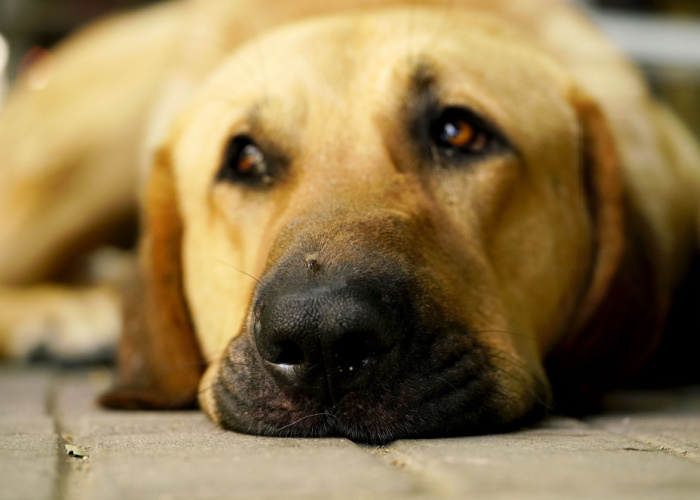
My Dog Ate a Fly: Final Thoughts
My dog ate a fly! Is my dog in any danger?
Yes and no.
Houseflies, on their own, are neither poisonous nor venomous, so your dogs are safe even if they’ve ingested one.
That being said, they’re vectors of various diseases and microbes.
Heck, they can even absorb toxins from pesticides, which would make your dog sick.
That’s why it’s essential to monitor your dog and check its state for a few days. Not hours, days!
And when you place a call with your vet, report everything you’ve observed after your dog ate a fly.
Observe your dog’s condition and take it to the hospital if there are noticeable to severe symptoms.
If you found this blog helpful, you might want to check out related articles about other things that your dog might accidentally eat.












